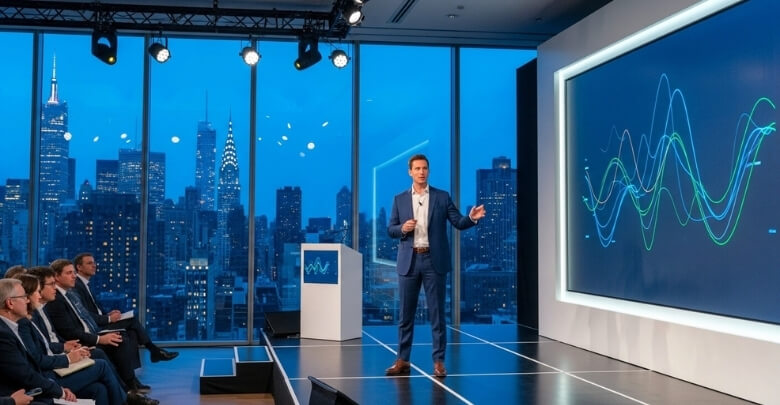Conferences give researchers and professionals a stage to share their work, discuss new ideas, and connect with others in their field. Presentations are at the heart of these events, but not every talk follows the same style. What are the common types of conference presentations?
The main presentation formats include oral talks, poster sessions, workshops, panels, and lightning talks. Each type serves a different purpose; some focus on quick insights, while others allow for deeper discussion or hands-on learning. Knowing these formats helps you choose the one that fits your goals.
Understanding these formats helps you prepare with confidence and deliver your ideas effectively. Keep reading to discover how each presentation type works, what makes it unique, and which one might be the perfect fit for your next conference.
What Are the Common Types of Conference Presentations?
Conferences are full of learning and sharing, but not every presentation looks the same. Some formats are short and snappy, while others allow for deep discussion or hands-on practice. Knowing the common types of conference presentations can help you choose the best way to share your ideas and connect with others.
Traditional Oral Presentations
This is the classic style where a speaker presents their work in front of an audience, usually with slides. An oral presentation in conference settings usually lasts 10–20 minutes. To do well, keep your message simple, your slides clear, and your timing on point.
Poster Sessions
Here, research or ideas are displayed on a large poster. Attendees walk around, stop by, and ask questions. It’s less formal than a stage talk and lets you connect with different experts across the globe in one-on-one conversations. A neat, easy-to-read poster works best.
Poster Template Idea:
You can use a simple three-column design:
- Left: Introduction & problem
- Middle: Methods & visuals (charts/images)
- Right: Results & key takeaways
Design Tips Included in the Template
- Use large fonts (minimum 24pt for body, 36pt+ for titles)
- Stick to 2–3 colors for consistency
- Keep plenty of white space for easy reading
- Limit word count to 500–700 words total
- Place visuals at eye level
Panel Discussions
Panels bring together a group of experts to talk about one topic. A moderator leads the conversation, and the audience may get to ask questions. Panels usually last 45–75 minutes and are best when you want to hear multiple viewpoints.
Interactive Workshops
Workshops are hands-on and practical. Instead of just listening, participants get involved through group activities, exercises, or role-playing. They work best for learning new skills or applying ideas to real situations.
Lightning Talks
These are short, timed talks, usually 5–7 minutes. They’re perfect when you have one strong message to share. Because time is tight, practice is key to making every word count.
Roundtable Discussions
Roundtables gather small groups to talk about a specific question or problem. Everyone has the chance to speak, making it more interactive. They usually last around an hour and are great for feedback on early ideas.
Symposia or Colloquia
These involve several presenters speaking on different parts of one theme. Each person gets a short time slot, and the session often ends with audience questions. It’s useful for exploring one topic in depth.
Demonstrations and Showcases
Sessions like this focus on showing a product, tool, or method live. They are practical, visual, and often enjoyable to watch. Demos work best when people can see immediate results.
Each format comes with its own strengths. Whether you’re sharing big results in an oral talk, sparking interest with a lightning talk, or encouraging teamwork in a workshop, choosing the right type can make your message memorable. The key is to match your presentation style with your goals and your audience.
Quick Overview of Conference Presentation Formats
Every conference offers different ways for people to share ideas. Some formats are short and to the point, while others allow more interaction or detailed discussion. These events often feature different forms of presentation, with the choice depending on time limits, audience size, and level of participation, both in-person and at virtual conferences. Keep reading to see which style works best in different situations.
Why Formats Differ
Conference formats aren’t one-size-fits-all. A 5-minute lightning talk is designed to spark quick interest, while a 90-minute workshop is built for teamwork and practice. These conference formats also include panels that highlight multiple voices, while posters let participants dive into details at their own pace.
Audience size also matters. Large audiences usually call for structured talks, while smaller groups benefit from open discussions like roundtables. Interactivity is another key difference; some formats are mostly listening, while others encourage everyone to join in.
What This Means for You
Understanding these differences helps you match your goals with the right presentation style. By being aware of different presentation formats, you can choose more confidently. If you want quick visibility, choose a lightning talk. If you need in-depth feedback, go for a poster or roundtable. And if you want to teach a skill, a workshop is best.
Conference Formats at a Glance
| Format | Typical Length | Audience Size | Interaction Level | Best For |
| Oral Presentation | 10–20 minutes | Medium–Large | Low–Medium | Sharing polished research or findings |
| Poster Session | Flexible (1–2 hrs) | Small–Medium | High (1-on-1) | Detailed feedback, networking |
| Panel Discussion | 45–75 minutes | Large | Medium–High | Multiple viewpoints, expert debate |
| Interactive Workshop | 60–120 minutes | Small–Medium | Very High | Teaching skills, applied learning |
| Lightning Talk | 5–7 minutes | Medium–Large | Low | Concise key points, quick impact |
| Roundtable Discussion | 60–75 minutes | Small | Very High | Open dialogue, early-stage ideas |
| Symposium/Colloquium | 60–90 minutes | Medium–Large | Medium | Thematic depth, multi-speaker session |
| Demonstration/Showcase | 15–30 minutes | Medium–Large | High (visual/practical) | Showing tools, products, or methods |
The format you choose can frame the impact of your presentation. Knowing the right conference presentation format ahead of time makes it easier to share your message effectively and connect with the audience in the way that fits best.
Importance of Conference Presentations
Conferences become meaningful because of the presentations that bring ideas to life. They create space for learning, sharing, and connecting in ways that books or articles alone cannot. Here’s a closer look at why presentations matter so much in these settings.
Learning
Presentations help participants find new insights and practical ideas from experts and peers. They keep professionals updated with the latest trends, methods, and practices in their field, making conferences an excellent opportunity to grow knowledge that supports both personal and professional improvement.
Networking
Presentations naturally connect people who share similar interests. After a talk or during a poster session, conversations often begin, leading to future collaborations, mentorships, or friendships. This creates valuable opportunities for attendees to strengthen their professional circles and expand their long-term connections.
Career Growth
Presenting at a conference builds visibility and shows confidence in one’s expertise. It adds credibility to a speaker’s profile, highlights their skills, and demonstrates leadership potential. These benefits can translate into better opportunities for recognition, future projects, and meaningful career advancement.
Knowledge Sharing
Presentations allow professionals to spread their work beyond their immediate colleagues or team. By sharing ideas openly with a larger audience, presenters invite feedback, gain new perspectives, and inspire others, making the event a space where ideas can move forward collectively.
Community Building
Presentations create a sense of belonging by bringing people together around shared interests and goals. They encourage discussion, inspire collaboration, and strengthen professional communities. Over time, this builds lasting networks where people support each other and grow together beyond the event.
The true value of conference presentations lies in how they educate, connect, and empower. By appreciating these benefits, both presenters and attendees can approach conferences with greater clarity and purpose.
How to Choose the Right Format?
Not every presentation format works for every purpose. The type you choose depends on what stage your work is in, the kind of interaction you want, and how much time you have. Picking the right format can make your presentation far more effective, so let’s break it down clearly.
Early-Stage Research → Poster Or Roundtable
These formats are ideal when your work is still developing. A poster lets you share details visually and chat with people one-on-one, while a roundtable invites open discussion and feedback in a smaller group setting.
Skills Transfer → Workshop
If your goal is to teach a skill or show how something works in practice, a workshop is the perfect choice. It encourages hands-on learning, teamwork, and participation, which makes complex ideas easier to understand and apply.
Polished Study → Oral Talk
When your research is complete and ready for a structured audience, a conference oral presentation is the best fit. It gives you the spotlight to share your work in a clear, concise way, usually supported by slides or visuals.
Broad Theme → Symposium or Panel
For larger topics that need multiple perspectives, panels and symposia are the right formats. A panel brings experts together for conversation, while a symposium organizes talks under one theme, offering more depth and variety.
Quick update → Lightning Talk
If you only need a few minutes to get your key point across, lightning talks work best. They keep the focus sharp, grab attention, and are perfect for new ideas, small projects, or early results.
Choosing the right format is about matching your message to the setting. Once you know your goal, the right option becomes clear, and that choice makes your work easier to present and more enjoyable for the audience.
Tips for Conference Presentations
Great presentations aren’t only about what you say but also how you deliver it. Small changes in structure, visuals, and delivery can make a big difference in how your audience receives your message. Let’s go through some key tips to help you shine.
- Know Your Audience: Understand who you’re speaking to and adjust your examples, tone, and vocabulary. When your content matches their interest level, it’s much easier to keep them engaged and connected to your talk.
- Present Yourself Professionally: First impressions matter, and how you look sets the tone before you even begin. Always wear proper dress for the conference, as it shows respect for your audience and helps you appear confident and credible.
- Structure Your Presentation: Begin with a clear opening, follow with organized points, and close with a short summary. A simple structure makes your content easier to follow and helps the audience remember the key ideas.
- Visual Aids: Use slides, charts, or images to support your points, but keep them clean and easy to read. Visuals should highlight your message, not compete with it, so keep text and clutter to a minimum.
- Engagement: Encourage the audience to participate with questions, small prompts, or short activities. Simple interactions keep people attentive and make your presentation feel more like a conversation.
- Practice: Rehearse several times to become comfortable with timing and delivery. The more you practice, the more confident and natural you’ll feel when presenting in front of others.
- Handle Questions: Listen carefully, respond briefly, and stay respectful even if you disagree. If you don’t know the answer, it’s fine to admit it and offer to follow up later.
These simple tips can turn a good presentation into a memorable one. By preparing well, staying clear, and connecting with your audience, you’ll not only share your work effectively but also feel more confident when presenting at conferences, leaving a lasting impression.
Common Challenges in Presentations
Even with strong preparation, every presenter runs into challenges. Some issues are simple, like going over time, while others, such as nervousness or audience disengagement, need a bit more care. The good thing is, each of these has a practical fix.
Time Management
Running over time or rushing through the last slides is a common mistake. To avoid this, rehearse with a timer and trim unnecessary content. Aim to finish a minute or two early so you don’t feel pressured, and your ending feels strong instead of rushed.
Technical Problems
Projectors, microphones, or slides sometimes stop working at the worst moment. The solution is simple: arrive early, test all equipment, and keep backups. Bring your slides on a USB drive, email yourself a copy, and carry printouts of your key points in case screens fail.
Stage Fright
Nerves hit almost everyone, especially with larger audiences. To handle it, practice until you feel comfortable, take deep breaths before starting, and slow down your opening. Make eye contact with friendly faces in the audience, and remind yourself that people want to hear what you have to say.
Audience Disengagement
Even great topics can lose attention if the presentation feels flat. Break your talk into shorter sections and use visuals to hold interest. Ask quick questions, invite a show of hands, or use simple stories to pull the audience back in and keep them involved.
These challenges may seem intimidating, but they’re part of almost every presenter’s experience. By preparing for them and having simple fixes ready, you’ll feel more confident and make your presentation stronger, no matter what comes up.
Frequently Asked Questions
Before wrapping up, here are some of the questions people often have after learning about conference presentation formats. These FAQs give short, clear answers to help you prepare with confidence.
Can I Use Humor in a Conference Presentation?
Yes, you can use light humor, but keep it professional and relevant to your topic. A small, well-placed joke can ease tension and make your talk engaging. Just avoid anything that might distract or offend the audience.
How Early Should I Arrive Before My Presentation?
Arriving at least 20–30 minutes early is smart. This gives you time to check the equipment, arrange your notes, and settle in. Being ready early also helps reduce last-minute nerves before you start speaking.
Do Conference Presenters Need to Follow a Dress Code?
Most conferences expect professional or business casual attire. Dressing neatly shows respect for the audience and the event. If unsure, check the event guidelines or look at how previous speakers dressed.
What Should I Do If My Slides Stop Working?
Stay calm and keep speaking while the issue is fixed. Having printed notes or a backup copy on a USB drive helps. Audiences usually appreciate when speakers handle technical issues confidently without losing focus.
Is It Okay to Read Directly From Notes?
It’s best not to read word-for-word, as it reduces connection with the audience. Instead, use notes as a guide for key points. Making eye contact while speaking makes you appear more confident and trustworthy.
How Many Slides Should I Use for a 15-minute Talk?
A good rule is one slide per minute, but quality matters more than quantity. Keep slides simple, avoid overcrowding with text, and focus on visuals that highlight your main ideas instead of repeating everything you say.
Can I Share My Presentation With Attendees Afterwards?
Yes, many conferences encourage sharing slides or a summary with the audience. It helps attendees review your key points later. You can email it, upload it to the conference platform, or provide a downloadable link.
Concluding Words
Conferences bring people together to share ideas, but the way those ideas are presented makes all the difference. Each format has its own style, from formal talks to interactive sessions, and choosing wisely can shape the outcome of your presentation.
When people ask what are the common types of conference presentations, the answer includes oral talks, posters, workshops, panels, lightning sessions, roundtables, symposia, and demonstrations. Each option has unique strengths, so matching your content with the right format is key.
By understanding these choices, you can prepare more effectively, connect with your audience, and leave a lasting impact. Whether you want quick feedback, deep discussion, or skill-building, the right presentation format will help you achieve your goals with confidence.








